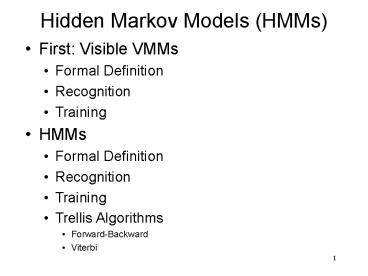Visible Markov Models - PowerPoint PPT Presentation
1 / 10
Title:
Visible Markov Models
Description:
1. Hidden Markov Models (HMMs) First: Visible VMMs. Formal Definition. Recognition. Training ... Let's revisit speech for a moment. In speech we are given a ... – PowerPoint PPT presentation
Number of Views:20
Avg rating:3.0/5.0
Title: Visible Markov Models
1
Hidden Markov Models (HMMs)
- First Visible VMMs
- Formal Definition
- Recognition
- Training
- HMMs
- Formal Definition
- Recognition
- Training
- Trellis Algorithms
- Forward-Backward
- Viterbi
2
Visible Markov Models
- Probabilistic Automaton
- N distinct states S s1, , sN
- M-element output alphabet K k1, , kM
- Initial state probabilities ? pi, i ? S
- State transition at t 1, 2,
- State trans. probabilities A aij, i,j ? S
- State sequence X X1, , XT, Xt ? S
- Output seq. O o1, , oT, ot ? K
3
VMM Weather Example
4
Generative HMM
- We choose the state sequence probabilistically
- Lets try this using
- the numbers 1-10
- drawing from a hat
- an ad-hoc assignment scheme
5
2 Questions
- Training Problem
- Given an observation sequence O and a space of
possible models which spans possible values for
model parameters w A, ?, how do we find the
model that best explains the observed data? - Recognition (decoding) problem
- Given a model wi A, ?, how do we compute how
likely a certain observation is, i.e. P(O wi) ?
6
Training VMMs
- Given observation sequences Os, we want to find
model parameters w A, ? which best explain
the observations - I.e. we want to find values for w A, ? that
maximises P(O w) - A, ? chosen argmax A, ? P(O A, ?)
7
Training VMMs
- Straightforward for VMMs
- frequency in state i at time t 1
- (number of transitions from state i to state j)
- --------------------------------------------------
--------------------------------------------------
--------------------------------------------------
------------------- - (number of transitions from state i)
- (number of transitions from state i to state j)
- --------------------------------------------------
--------------------------------------------------
--------------------------------------------------
------------------- - (number of times in state i)
8
Recognition
- We need to calculate P(O wi)
- P(O wi) is handy for calculating P(wiO)
- If we have a set of models L w1,w2,,wV then
if we can calculate P(wiO) we can choose the
model which returns the highest probability, i.e. - wchosen argmax wi ? L P(wiO)
9
Recognition
- Why is P(O wi) of use?
- Lets revisit speech for a moment.
- In speech we are given a sequence of
observations, e.g. a series of LPC vectors - E.g. LP coefficients taken from frames of length
20-40ms, every 10-20 ms - If we have a set of models L w1,w2,,wV then
if we can calculate P(wiO) we can choose the
model which returns the highest probability, i.e. - wchosen argmax wi ? L P(wiO)
10
wchosen argmax wi ? L P(wiO)
- P(wiO) difficult to calculate as we would have
to have a model for every possible observation
sequence O - Use Bayes rule
- P(x y) P (y x) P(x) / P(y)
- So now we have
- wchosen argmax wi ? L P(O wi) P(wi) / P(O)
- P(wi) can be easily calculated
- P(O) is the same for each calculation and so can
be ignored - So P(O wi) is the key!!!































